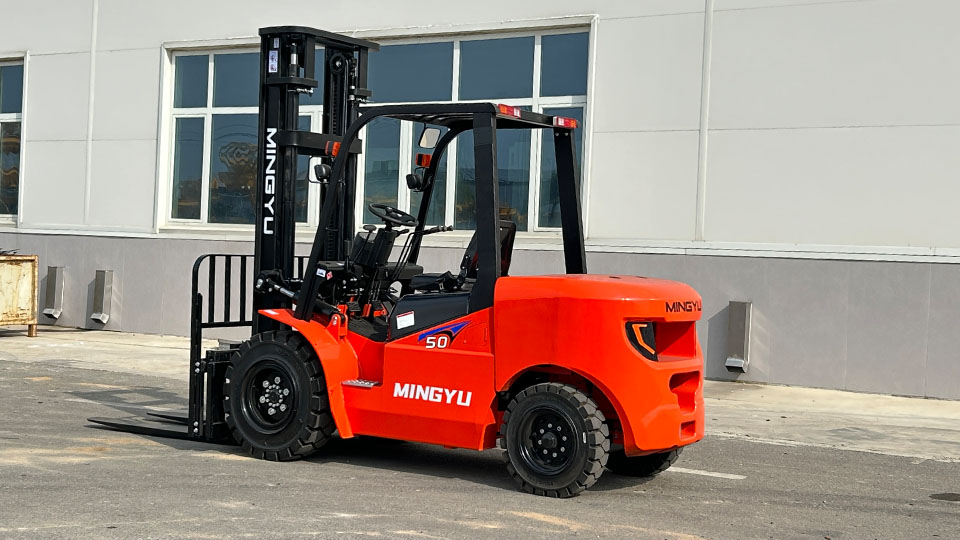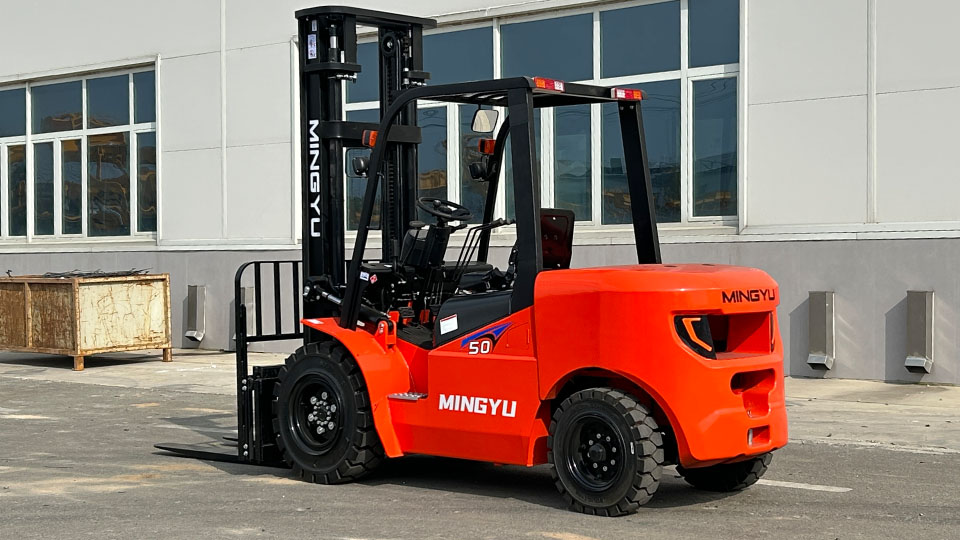
I. Introduction
Forklifts are indispensable tools in material handling, facilitating the efficient movement of goods across various industries. However, the safe transport of loads on a forklift is paramount to prevent accidents, injuries, and property damage. Proper load handling during travel requires a thorough understanding of safety protocols, equipment capabilities, and environmental conditions. This article provides a comprehensive guide to safe load handling practices when traveling on a forklift, ensuring operators can navigate their tasks with confidence and competence.
II. Pre-Travel Load Inspection and Preparation
Load Stability:
Before moving any load, assess its center of gravity to ensure it is balanced and stable.
Secure loose items and use straps or wrapping to prevent shifting during transit.
Identify potential instability issues and take corrective measures before travel.
Load Weight and Dimensions:
Verify the load's weight against the forklift's rated capacity to avoid overloading.
Check the load's dimensions to ensure it fits within the forklift's capabilities and the travel path's clearances.
Recognize how large loads can obstruct visibility and plan accordingly.
Fork Inspection and Positioning:
Inspect forks for cracks, bends, or other signs of damage.
Position forks correctly to provide stable support and ensure they are fully engaged with the pallet or load.
Adjust fork spacing to accommodate the load's width and prevent slippage.
III. Safe Travel Practices with a Load
Speed and Smooth Operation:
Maintain a safe, controlled speed to prevent sudden movements that could destabilize the load.
Avoid abrupt starts, stops, and sharp turns, which can cause the load to shift or fall.
Navigate inclines and uneven surfaces smoothly to maintain stability.
Visibility and Awareness:
Ensure clear visibility of the travel path by keeping the load low and using mirrors or other aids to minimize blind spots.
Maintain constant awareness of the surroundings, including pedestrians, obstacles, and other equipment.
Use a spotter if necessary, especially in congested or complex environments.
Load Height and Position:
Travel with the load lowered to a safe height, typically 4-6 inches above the ground, to maintain stability.
Understand how raising the load increases the forklift's center of gravity and reduces stability.
Adjust the load height as needed for clearance and visibility, but always prioritize stability.
Travel Path and Obstacles:
Plan the travel path in advance to avoid obstacles, uneven surfaces, and congested areas.
Navigate narrow aisles and confined spaces carefully, using slow and deliberate movements.
Communicate with other workers to coordinate movements and prevent collisions.
IV. Navigating Specific Travel Scenarios
Inclines and Ramps:
Approach inclines cautiously and at a controlled speed, ensuring the load is facing uphill.

Maintain a stable load position and avoid sudden movements that could cause the forklift to tip.
Understand how load weight and incline steepness affect stability.
Turns and Corners:
Slow down before entering turns and make wide, smooth turns to prevent load shifting or tipping.
Be aware of the forklift's turning radius and ensure sufficient clearance.
Avoid sharp turns, especially with heavy or unstable loads.
Elevators and Loading Docks:
Enter and exit elevators and loading docks slowly and carefully, ensuring proper clearance and weight distribution.
Follow specific procedures for these areas, including signaling and securing the forklift.
Ensure the elevator or loading dock can support the combined weight of the forklift and load.
Pedestrian Traffic Areas:
Exercise extreme caution in pedestrian areas, using audible warnings and hand signals to alert others.
Yield to pedestrians and maintain a safe distance, moving slowly and deliberately.
Use a spotter if necessary to ensure pedestrian safety.
V. Emergency Procedures and Potential Hazards
Load Shifting or Falling:
If a load begins to shift or fall, immediately lower the load to the ground if possible.
Move away from the falling load to avoid injury.
Implement preventive measures, such as proper load securing and balancing, to avoid future incidents.
Forklift Tipping or Overturning:
Understand the causes of forklift tipping, such as overloading, uneven surfaces, and sharp turns.
If the forklift begins to tip, brace yourself and lean away from the direction of the tip.
Prevent tipping by adhering to safe load handling and travel practices.

Collision Avoidance:
Implement strategies to prevent collisions, such as maintaining a safe following distance and using mirrors and signals.
Understand the importance of clear communication and signaling to avoid misunderstandings.
Maintain a constant awareness of surroundings and anticipate potential hazards.
VI. Training and Certification Requirements
OSHA Regulations and Standards:
Comply with OSHA requirements for forklift operator training and certification, including 29 CFR 1910.178.
Ensure operators are trained and certified on the specific type of forklift they operate.
Employers are responsible for providing adequate training and ensuring compliance.
Operator Competency and Evaluation:
Assess operator competency through practical and theoretical evaluations, ensuring they can operate forklifts safely and efficiently.
Provide ongoing training and refresher courses to maintain skills and knowledge.
Maintain accurate records of operator training and certification.
VII. Equipment Maintenance and Inspection
Pre-Shift Inspections:
Conduct thorough pre-shift inspections of the forklift, checking for any mechanical issues or damage.
Pay close attention to the forks, tires, controls, and safety devices.
Document inspection results and report any problems immediately.
Regular Maintenance and Repairs:
Follow the manufacturer's recommendations for regular maintenance and repairs.
Address any maintenance issues promptly to prevent equipment failures and accidents.
Ensure the forklift is in optimal working condition at all times.
VIII. Environmental Factors and Conditions
Weather Conditions:
Adjust travel practices for rain, snow, or ice, which can affect traction and visibility.
Use appropriate safety measures, such as reducing speed and increasing following distance, in adverse weather.
Ensure the forklift is equipped with appropriate tires and safety features for the conditions.
Surface Conditions:
Adapt travel practices for uneven or slippery surfaces, which can affect stability and control.
Maintain a safe travel speed and distance, and be aware of potential hazards.
Ensure the forklift is equipped with appropriate tires and suspension for the conditions.
IX. Communication and Signaling
Hand Signals and Audible Warnings:
Use standardized hand signals for communication, especially in noisy environments.
Utilize audible warnings, such as horns or alarms, to alert pedestrians and other operators.
Ensure clear and effective communication to prevent misunderstandings and collisions.
Two-Way Radios and Other Communication Devices:
Use two-way radios or other communication devices in large or noisy environments to maintain contact.
Ensure clear and concise communication, following established protocols.
Use communication devices to coordinate movements and prevent collisions.
X. Conclusion
Safe load handling when traveling on a forklift requires a combination of proper training, equipment maintenance, and adherence to safety protocols. By understanding and implementing the practices outlined in this guide, operators can minimize risks and ensure efficient and safe material handling operations. Continuous training, vigilance, and a commitment to safety are essential for maintaining a safe workplace and preventing accidents.
Name: selena
Mobile:+86-13176910558
Tel:+86-0535-2090977
Whatsapp:8613181602336
Email:vip@mingyuforklift.com
Add:Xiaqiu Town, Laizhou, Yantai City, Shandong Province, China